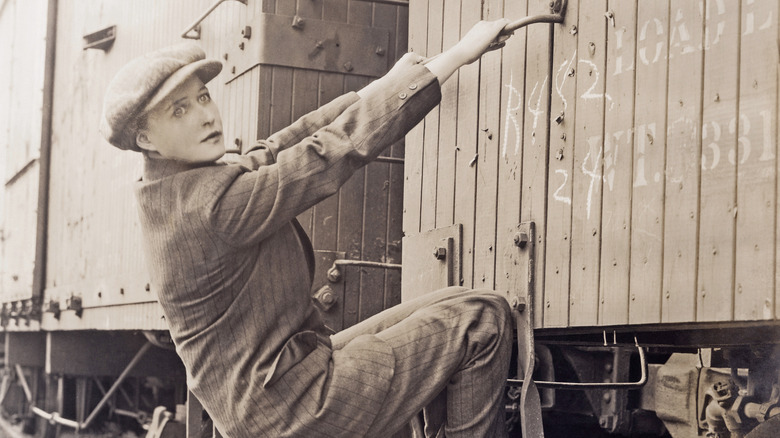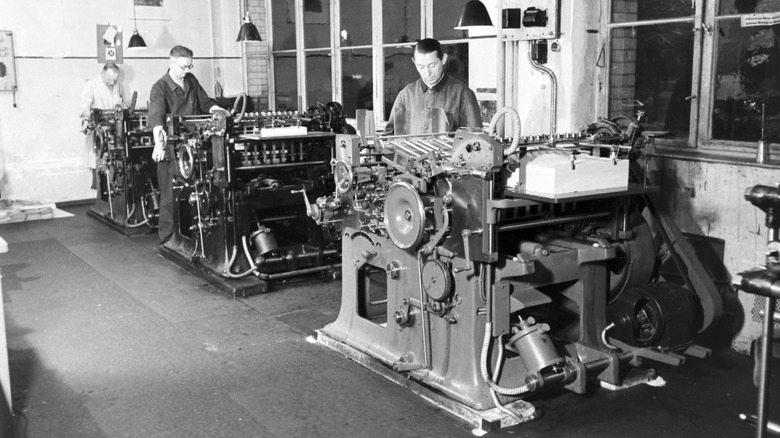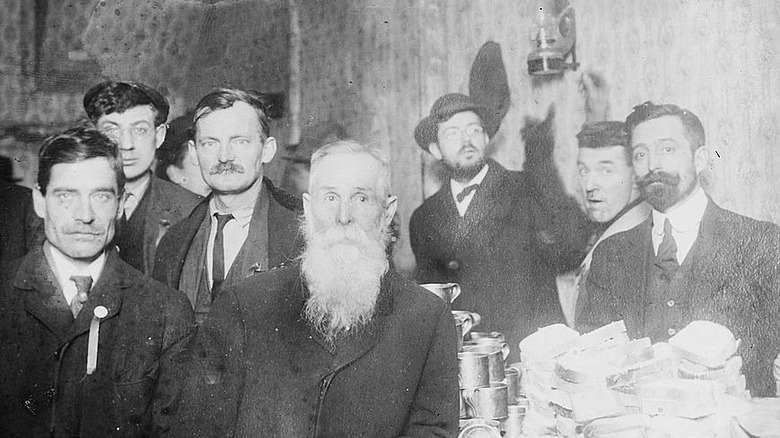The Hobo Code Of Ethics Explained
If you were to hear the words hardworking, ethical, and honest, would you automatically conjure the image of a 19th-century train-hopping hobo? If your answer was no, you might want to revisit this chapter in your history books or better yet revise it to fit the latest script. As we dig deeper into the crates and freight trains of our national past, we're gaining a more accurate depiction of who the people known as hobos really were, and chances are this will shatter every stereotype you've previously held of them.
According to Open Culture, many of those individuals made homeless during the economic turmoil that followed the Civil War were not only hard-working but also quite ethical. In fact, they even had their very own code of ethical behavior (via Globe Gazette). Historians call it the hobo code and it speaks volumes about the true nature of the people who endured homelessness amid the backdrop of the great American steam engines clouding smoke across the country.
The people from that era known as hobos worked harder than most modern Americans
Today, the word hobo carries a deeply negative connotation that is almost synonymous with the word bum. Any mention of a hobo immediately incites imagery of a middle-aged man with a bag slung over his back, hopping trains and living freely off the land. Indeed, it is even associated with the loose and criminal lifestyle of a wanderer who has chosen for himself a life without rules and is resigned to the railroad tracks to wander aimlessly on someone else's dime.
Collectors Weekly reports that was not always the case. During the era of the American railway, in the wake of the Great Depression, the transient workers referred to as hobos were viewed as the opposite of bums. Theirs were the hard-working hands that crafted the steel of steam engines and as an uncertain kind of gig economy swept the nation — theirs was the sweat of a hard-earned, laborious day.
According to History Daily, hobos strived to make the best of the short-term positions sparsely available as hundreds of thousands lived unemployed, contracting their freedom for a days' spoils. They toiled in the fields, tinkered on the train tracks, and moiled in the factories, creating a prideful new class of transient residents that were revered and even romanticized through art and literature.
They lived their lives intentionally and by a strict street code
Just because these individuals' lives relied on the rails doesn't mean they lived recklessly without rules. History Daily reports that these resourceful transient workers created their own makeshift communities from what little supplies they could scrape together. These communities, sometimes called hobo jungles, functioned independently from the rest of society, providing a safe space to eat, sleep, and exchange stories from the road.
In an archived print article, LA Times reporter Nikki Finke compared this subset of laborers to migratory birds and their jungles to natural canvases of inspiration (via Los Angeles Times). Hobo jungles were often situated on the outskirts of a seasonal employment location like the Sierra Nevada, which was once bursting with trout fishing and lumbering employment opportunities. From these jungles emerged not just a new class of people, but also a brand-new culture, complete with its very own street code. This code came to be known as the hobo code of ethics (per Open Culture).
The hobo code of ethics was reportedly established during the National Hobo Convention
The shifting, tragic saga of transient workers traversing the United States via freight train has undoubtedly shaped much of modern America. Hobos and their codes have left massive marks on pop culture, showing up in cinematic pictures such as the 2018 neo-noir film 'Under the Silver Lake" which won special mention at the Catalonian International Film Festival and was nominated for Faro Island Film Festival's Best Motion Picture of the Year award (via IMDb). Hobo codes have also graced the screens of television via episodes of the critically acclaimed drama "Mad Men", which is not to mention their presence in modern-day museums such as the National Cryptologic Museum (per NSA). But where did these codes originate from in the first place?
According to Open Culture, the Hobo Code of Ethics, from which other infamous hobo codes derived, was reportedly established during the Hobo National Convention of 1889. As a way of separating themselves from non-working individuals who also rode the rails, this code was said to hold hobos to a "knightly standard." Sadly, this strict and perilous lifestyle often translated to an early grave. Vice reports that between 1898 and 1908, approximately 48,000 transient workers lost their lives in various train mishaps while trying to live up to these knightly conditions.
'decide your own life'
Open Culture reports that there were 15 rules in total and rule No. 1 was "Decide your own life." While a simple code on the surface, it speaks volumes to the arduous conditions many hobos faced as everyone from employers to police officers to the general public took potshots at their livelihoods and reputations. This rule placed a heavy emphasis on self-reliance and not letting anyone else rule over you.
Other parts of the ethical code instructed hobos to respect the laws of mankind and nature, to pitch in when staying in hobo jungles, to avoid belligerence and/or drunkenness, to constantly be in search of work, and to look out for each other. Two of their rules even addressed how to interact with children i.e — not to abuse them, and if abuses were known, a person should report it to the police. The code also included trying to help runaways, with an emphasis on urging them to go back home.
These golden rules were established as a point of distinction between the hobo and the bum, who was a more visible vagrant but accounted for a smaller percentage of the overall population. According to author Errol Lincoln Uys who penned "Riding the Rails", somewhere between 85% and 98% of all hobos were on the road in search of work, armed with these guidelines of diligence (via Breaking Trail).
The hobo code of ethics worked in tandem with hobo graffiti to cement an unwavering legacy
According to Smithsonian Magazine, the vagabonds of the past had a rich culture all their own. As economic instability ravaged much of the nation, some estimate that the number of men experiencing homelessness was as high as 2 million (via Living History Farm). This includes 250,000 teenagers and perhaps about 8,000 women (per PBS). With such a vast number of people relegated to the fringes of society, it makes sense that they found comradery in one another, to the point where they created their own forms of communication.
While the hobo code of ethics mapped out a lifestyle centered on respect for nature, locals, hygiene, and the law, hobo graffiti was a series of sketches historians believed were used to alert new-coming hobos of their surroundings (via Vox). While present-day America is so obsessed with hobo culture that we even depicted Superman as riding the rails in the epic "Man of Steel," it's important to note that these codes and pictographs were never designed to entertain the masses by gracing the walls of museums or the reels of motion pictures. They were created so that a subset of people wrongfully labeled as subhuman in the eyes of many, could do one of the most human things of all -– survive.





